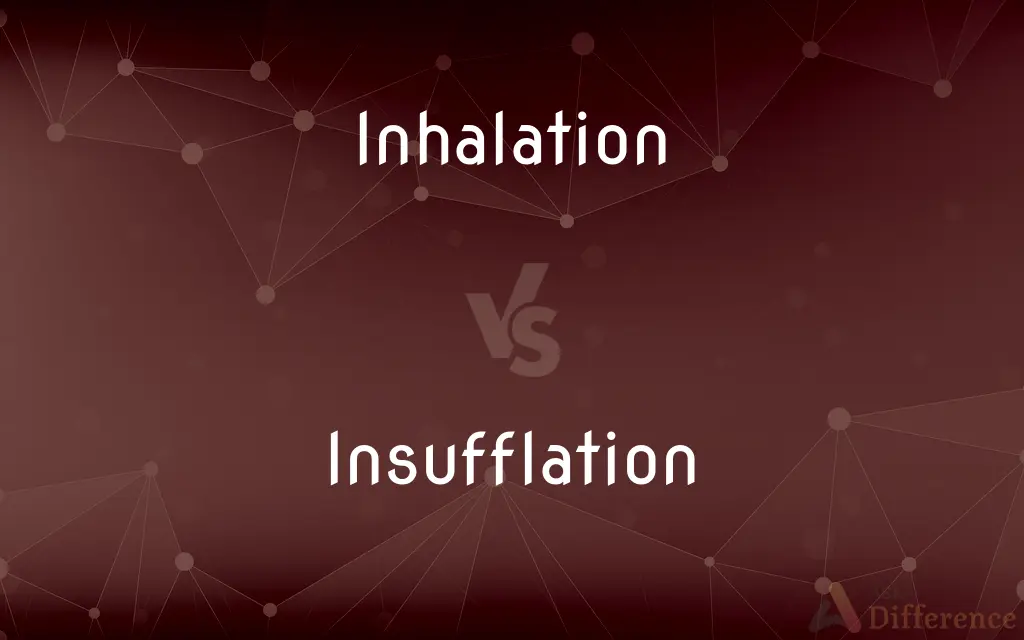Inhalation vs. Insufflation — What's the Difference?
By Tayyaba Rehman & Fiza Rafique — Updated on March 28, 2024
Inhalation involves breathing in through the nose or mouth, while insufflation is the act of blowing a substance into a body cavity.

Difference Between Inhalation and Insufflation
Table of Contents
ADVERTISEMENT
Key Differences
While inhalation is a voluntary or involuntary action that occurs as part of normal breathing, insufflation is typically a deliberate action with a specific purpose, such as drug administration or medical examination. For example, certain medications are insufflated to provide rapid effects by bypassing the digestive system and entering the directly through the mucous membranes.
In terms of medical procedures, insufflation can be used for diagnostic purposes, such as in endoscopy where gas is blown into the gastrointestinal tract to expand it for better visualization. Conversely, inhalation therapy involves breathing in aerosolized medications to treat respiratory conditions like asthma or chronic obstructive pulmonary disease (COPD).
The equipment and substances used in each process differ significantly. Inhalation might involve simple devices like inhalers or nebulizers for medication delivery, or no devices at all when referring to normal breathing. Insufflation, however, often requires specific tools like insufflators for medical procedures or simple tubes for recreational drug use.
Safety and health implications vary between the two. Inhalation, especially of clean air, is generally safe and necessary for life. However, inhaling harmful substances can lead to respiratory issues. Insufflation of drugs or other substances carries risks such as infection, damage to mucous membranes, or overdose, depending on the substance insufflated and the method used.
Comparison Chart
Definition
Breathing in air or gases
Blowing substances into a body cavity
ADVERTISEMENT
Purpose
Gas exchange, medication delivery
Diagnostic, therapeutic, recreational purposes
Method
Through nose or mouth
Using tools or devices into specific body cavities
Substances
Air, aerosolized medications
Powders, gases, vapors
Medical Use
Respiratory treatments
Endoscopy, direct drug delivery
Equipment
Inhalers, nebulizers
Insufflators, tubes
Safety
Generally safe (with clean air)
Risks of infection, membrane damage, overdose
Compare with Definitions
Inhalation
Inhaling aerosolized drugs.
Inhalation of corticosteroids is a common treatment for COPD.
Insufflation
Blowing drugs into the nasal cavity.
Insufflation of certain medications can provide rapid relief from symptoms.
Inhalation
A part of normal respiration.
Deep inhalation is recommended during meditation for relaxation.
Insufflation
Administering medication directly.
Some vaccines are given by insufflation for direct mucosal immunization.
Inhalation
Drawing in breath.
Inhalation of the fresh mountain air felt rejuvenating.
Insufflation
Diagnostic technique in medicine.
Insufflation with carbon dioxide is used in endoscopy to distend the gastrointestinal tract.
Inhalation
Breathing air into the lungs.
Inhalation of polluted air can lead to respiratory problems.
Insufflation
Recreational drug use method.
Cocaine is often used through insufflation for its immediate effects.
Inhalation
Using an inhaler for medication.
Asthma patients often rely on inhalation therapy for immediate relief.
Insufflation
Medical procedure to expand an organ.
Insufflation of the abdomen is performed during laparoscopic surgery for better visibility.
Inhalation
Inhalation happens when air or other gases enter the lungs.
Insufflation
In religious and magical practice, insufflation and exsufflation are ritual acts of blowing, breathing, hissing, or puffing that signify variously expulsion or renunciation of evil or of the devil (the Evil One), or infilling or blessing with good (especially, in religious use, with the Spirit or grace of God). In historical Christian practice, such blowing appears most prominently in the liturgy, and is connected almost exclusively with baptism and other ceremonies of Christian initiation, achieving its greatest popularity during periods in which such ceremonies were given a prophylactic or exorcistic significance, and were viewed as essential to the defeat of the devil or to the removal of the taint of original sin.Ritual blowing occurs in the liturgies of catechumenate and baptism from a very early period and survives into the modern Roman Catholic, Greek Orthodox, Maronite, and Coptic rites.
Inhalation
The act or an instance of inhaling.
Insufflation
The act or an instance of insufflating.
Inhalation
An inhalant.
Insufflation
(Ecclesiastical) A ritual act of breathing on baptismal water or on the one being baptized.
Inhalation
The act of inhaling; inbreathing.
Insufflation
The action of breathing or blowing into or on.
Inhalation
The substance (medicament) which is inhaled.
Insufflation
The result of breathing or blowing into or on.
Inhalation
The act of inhaling; also, that which is inhaled.
Insufflation
The ritual breathing onto the water used for baptism
Inhalation
The act of inhaling; the drawing in of air (or other gases) as in breathing
Insufflation
The act of breathing on or into anything
Inhalation
A medication to be taken by inhaling it
Insufflation
(medicine) blowing air or medicated powder into the lungs (or into some other body cavity)
Insufflation
An act of blowing or breathing on or into something
Common Curiosities
Can insufflation be used for medical treatments?
Yes, it's used for both diagnostic procedures and direct delivery of medications to specific sites in the body.
Is inhalation therapy the same as using an inhaler?
Inhalation therapy often involves using an inhaler or nebulizer to deliver medication directly to the lungs.
What are the risks associated with insufflation?
Risks include infection, damage to mucous membranes, and potential overdose, depending on the substance used.
What equipment is used for insufflation in medical settings?
Insufflators and specific tubes or catheters are used to administer gases or powders into body cavities.
How does inhalation contribute to respiratory health?
Proper inhalation, especially of clean air, is essential for oxygen delivery to the body and removal of carbon dioxide.
What is the primary difference between inhalation and insufflation?
Inhalation is the act of drawing air or gases into the lungs, while insufflation involves blowing substances into a body cavity for various purposes.
What safety precautions are associated with inhalation therapy?
It includes ensuring the correct dosage, using the inhaler or nebulizer properly, and avoiding inhaling harmful substances.
Can you inhale something other than air?
Yes, inhalation can involve breathing in aerosolized medications, vapors, or other gases besides air.
Why is insufflation used in recreational drug use?
It provides rapid effects by delivering the drug directly through mucous membranes.
Is normal breathing considered inhalation?
Yes, normal breathing involves the inhalation of air and is a critical component of respiratory function.
Share Your Discovery

Previous Comparison
Secretarial vs. Secretariat
Next Comparison
Bombastic vs. OrotundAuthor Spotlight
Written by
Tayyaba RehmanTayyaba Rehman is a distinguished writer, currently serving as a primary contributor to askdifference.com. As a researcher in semantics and etymology, Tayyaba's passion for the complexity of languages and their distinctions has found a perfect home on the platform. Tayyaba delves into the intricacies of language, distinguishing between commonly confused words and phrases, thereby providing clarity for readers worldwide.
Co-written by
Fiza RafiqueFiza Rafique is a skilled content writer at AskDifference.com, where she meticulously refines and enhances written pieces. Drawing from her vast editorial expertise, Fiza ensures clarity, accuracy, and precision in every article. Passionate about language, she continually seeks to elevate the quality of content for readers worldwide.














































